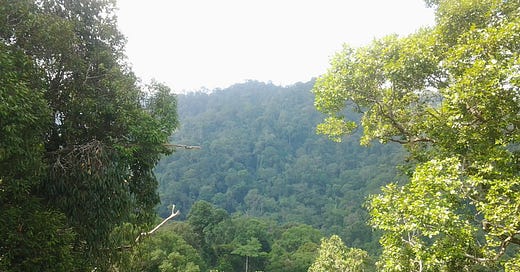Tropical rainforests and the water cycle (1)
[Students often have to study rainforests, and all A Level students in the UK have to study the water cycle. This is the first of two Substacks that link these two topics together.]
Tropical rainforests are located in low latitudinal areas (up to 10 degrees N and S). The Amazon Basin has the largest area of rainforest in the world. The Amazonian climate is hot and wet; for example, at Uaupes in Brazil on the equator, mean monthly temperatures range between 25 and 27°C and rainfall averages 2677mm per annum. Most precipitation occurs as heavy convectional storms, and skies are often cloudy. Rainfall is evenly distributed throughout the year in the western part of Amazonia, but southern and eastern areas experience a short dry season, although precipitation is still sufficient for rainforest.
Net Primary Productivity (NPP) is very high; the biome is the most biologically diverse ecosystem in the world. Although estimates vary, there are about 1,300 bird, 428 amphibian, 427 mammal and 378 reptile species, and 3,000 types of fish.
Flora as well as fauna are highly diverse. The vegetation is usually vertically stratified into four layers: emergent, canopy, under-canopy, and shrub and herb (Figure 1). The forest appears to be evergreen because foliage is always present, but only the palm tree grows and sheds its leaves continually. Most trees instead have flushes of growth; for example, the Brazil nut, a dry season deciduous tree, sheds its leaves well before bud break. Others, known as leaf exchangers, shed their leaves while buds break, whereas others lose their leaves after the buds’ break.
Figure 1. Rainforest structure
Many of the world’s tropical forests are under threat from anthropogenic (human) activities. A key direct human impact is the removal of the forest vegetation, which can be partial (degradation), or more comprehensive (deforestation). There are several reasons for this, including clearing land for crops or cattle pasture, urbanisation and building infrastructure such as roads. Indirect human impacts include the warming and drying of these environments driven by global changes in climate, which further threaten vegetation communities. All these perturbations impact the water cycle.
The water cycle in undisturbed tropical rainforests
Rainfall tends to be high, with frequent and intense rainstorms. The hot temperatures at the equator facilitate high rates of evaporation from seas and oceans, as warm air can hold more moisture. This warm, moist air is then blown on land by prevailing winds and weather systems. The water vapour in the air condenses as the air cools, leading to convectional rainfall events.
In densely vegetated tropical rainforests, a large portion of this rainfall is intercepted by trees and other flora, as raindrops falling towards the ground are caught on their leaves. Much of this intercepted water is evaporated directly back into the atmosphere, meaning it never reaches the underlying land.
The ground surface in tropical rainforests is covered by a litter layer, formed as trees continually shed leaves which fall to the forest floor. This organic matter can decompose rapidly, forming humus. Where soils have well-developed litter and humus layers, water can soak into the soil more easily - infiltration. In tropical rainforests, most of the rain that reaches the ground infiltrates into the soil, with little overland flow across the surface.
Much of the water in the soil is taken up by vegetation. Most forest species have very shallow roots, so they can access water just below the soil surface. This water is moved up through the vegetation and is lost back into the atmosphere as water vapour through the stomata, via the process of transpiration. Any soil water that isn’t taken up by plant roots or evaporated from the soil surface moves slowly through the soil towards streams and rivers as throughflow, maintaining steady river flows.
The water that is evaporated from leaves following interception, transpired by vegetation, or evaporated directly from the soil, re-enters the atmosphere as water vapour. This helps to maintain humid conditions in tropical rainforests, and when the moisture in the air condenses it will fall again as rainfall. In this way, water is ‘recycled’, and can fall many times as rain, each time being returned to the atmosphere as water vapour through evaporation and transpiration. As air continues to be blown inland, this recycling of water means that areas far away from seas and oceans still receive enough rainfall to support the dense forest vegetation.
[The next Substack will examine the impact of disturbance on the water cycle]




